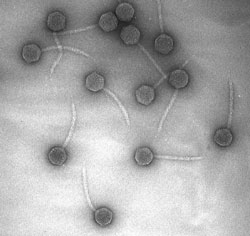
The bacterial virus known as the "phage" is perhaps the world’s most simple biological entity capable of directing its own duplication. The phage is little more than a strand of DNA contained within a protein coat. This simplicity was attractive to early researchers trying to determine whether the molecules of inheritance were proteins or DNA. In a famous "blender" experiment at Cold Spring Harbor Laboratory, Alfred Hershey and Margaret Chase allowed phages tagged with radioactive ions to infect a cell, and confirmed that DNA was indeed the hereditary molecule. For more details, see a diagram of the famous blender experiment on the Access Excellence Web site.
"The idea was that you could do experiments overnight; if you were breeding corn, you could only have one cross per year. If you went down to Florida, maybe you’d have two crosses per year. With phages you can get a cross every day." — James Watson , Co-discoverer of the DNA double helix and president of Cold Spring Harbor Laboratory
On
viruses and the way genes are organized:
— Eric Lander , Director, Whitehead Institute's Center for Genome Research |
||||||

 On
the phage bacterial virus as one of the original model organisms
for genetics:
On
the phage bacterial virus as one of the original model organisms
for genetics: